| Vaquero from Wikipedia
The vaquero (Spanish: vaquero or Portuguese: vaqueiro)
is a horse-mounted livestock herder of a tradition that originated on the
Iberian peninsula. Today the vaquero is still a part of the doma vaquera,
the Spanish tradition of working riding. The vaquero traditions developed
in Mexico from methodology brought to Mesoamerica from Spain also became
the foundation for the North American cowboy.
The vaqueros of the Americas were the horsemen and cattle
herders of Spanish Mexico, who first came to California with the Jesuit
priest Eusebio Kino in 1687, and later with expeditions in 1769 and the
Juan Bautista de Anza expedition in 1774. They were the first cowboys in
the region.
In the modern United States and Canada, remnants of two
major and distinct vaquero traditions remain, known today as the "Texas"
tradition and the "Spanish", "Vaquero", or "California" tradition. The
popular "horse whisperer" style of natural horsemanship was originally
developed by practitioners who were predominantly from California and the
Northwestern states, clearly combining the attitudes and philosophy of
the California vaquero with the equipment and outward look of the Texas
cowboy. The natural horsemanship movement openly acknowledges much influence
of the vaquero tradition.
The cowboys of the Great Basin still use the term "buckaroo",
which may be a corruption of vaquero, to describe themselves and their
tradition.
Etymology
| Vaquero is a Spanish word for a herder of cattle. It
derives from vaca, meaning "cow", which in turn comes from the Latin word
vacca.
A related term, buckaroo, still is used to refer to a
certain style of cowboys and horsemanship most often seen in the Great
Basin region of the United States that closely retains characteristics
of the traditional vaquero. Some linguists have speculated that the words
"buckaroo" and "vaquero" may derive from Arabic words related to cattle,
transliterated by some as bakara or bakhara, and suggests the words may
have entered Spanish during the centuries of Islamic rule. The word for
cattle in Arabic: baqar, and the Arabic word baqqar means "cowherd".
History
The origins of the vaquero tradition come from Spain,
beginning with the hacienda system of medieval Spain. This style of cattle
ranching spread throughout much of the Iberian peninsula and later, was
imported to the Americas. Both regions possessed a dry climate with sparse
grass, and thus large herds of cattle required vast amounts of land in
order to obtain sufficient forage. The need to cover distances greater
than a person on foot could manage gave rise to the development of the
horseback-mounted vaquero. Various aspects of the Spanish equestrian tradition
can be traced back to Arabic rule in Spain, including Moorish elements
such as the use of Oriental-type horses, the jineta riding style characterized
by a shorter stirrup, solid-treed saddle and use of spurs, the heavy noseband
or hackamore, (Arabic: šakima, Spanish jaquima) and other horse-related
equipment and techniques. Certain aspects of the Arabic tradition,
such as the hackamore, can in turn be traced to roots in ancient Persia.
Arrival in the Americas
During the 16th century, the Conquistadors and other Spanish
settlers brought their cattle-raising traditions as well as both horses
and domesticated cattle to the Americas, starting with their arrival |
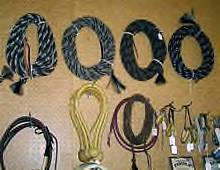
Classic vaquero style hackamore
equipment. Horsehair mecates top
row, rawhide bosals in second
row with other equipment
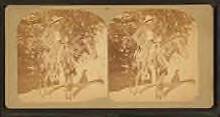
Image of a man and horse in
Mexican-style equipment,
horse in a two-rein bridle
|
in what today is Mexico and Florida. The traditions of Spain
were transformed by the geographic, environmental and cultural circumstances
of New Spain, which later became Mexico and the Southwestern United States.
In turn, the land and people of the Americas also saw dramatic changes
due to Spanish influence.
The arrival of horses in the Americas was particularly
significant, as equines had been extinct there since the end of the prehistoric
ice age. However, horses quickly multiplied in America and became crucial
to the success of the Spanish and later settlers from other nations. The
earliest horses were originally of Andalusian, Barb and Arabian ancestry,
but a number of uniquely American horse breeds developed in North and South
America through selective breeding and by natural selection of animals
that escaped to the wild and became feral. The Mustang and other colonial
horse breeds are now called "wild", but in reality are feral horses—descendants
of domesticated animals. Mesteñeros were vaqueros that caught, broke
and drove Mustangs to market in Mexico and later the American territories
of what is now Northern Mexico, Texas, New Mexico and California. They
caught the horses that roamed the Great Plains and the San Joaquin Valley
of California, and later in the Great Basin, from the 18th century to the
early 20th century.
18th and 19th centuries
| The Spanish tradition evolved further in what today is
Mexico and the Southwestern United States into the vaquero of northern
Mexico and the charro of the Jalisco and Michoacán regions. Most
vaqueros were men of mestizo and Native American origin while most of the
hacendados (ranch owners) were ethnically Spanish. Mexican traditions spread
both South and North, influencing equestrian traditions from Argentina
to Canada.
As English-speaking traders and settlers expanded westward,
English and Spanish traditions, language and culture merged to some degree.
Before the Mexican-American War in 1848, New England merchants who traveled
by ship to California encountered both hacendados and vaqueros, trading
manufactured goods for the hides and tallow produced from vast cattle ranches.
American traders along what later became known as the Santa Fe Trail had
similar contacts with vaquero life. Starting with these early encounters,
the lifestyle and language of the vaquero began a transformation which
merged with English cultural traditions and produced what became known
in American culture as the "cowboy".
Mesteñeros were vaqueros that caught, broke and
drove Mustangs to market in the Spanish and later Mexican, and still later
American territories of what is now Northern Mexico, Texas, New Mexico
and California. They caught the horses that roamed the Great Plains and
the San Joaquin Valley of California, and later in the Great Basin, from
the 18th century to the early 20th century.
|
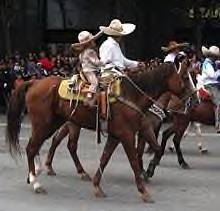
Modern child in Mexican parade wearing
charro attire on horse outfitted in
vaquero-derived equipment including
wide, flat-horned saddle, bosalito
and bit, carrying romal reins and reata |
Modern America
Distinct regional traditions arose in the United States,
particularly in Texas and California, distinguished by local culture, geography
and historical patterns of settlement. In turn, the California tradition
had an influence on cattle handling traditions in Hawaii. The "buckaroo"
or "California" tradition, most closely resemblied that of the original
vaquero, while the "Texas" tradition melded some Spanish technique with
methods from the eastern states, creating separate and unique styles indigenous
to the region. The modern distinction between vaquero and buckaroo within
American English may also reflect the parallel differences between the
California and Texas traditions of western horsemanship.
| California tradition
The Spanish or Mexican vaquero who worked with young,
untrained horses, arrived in the 1700s and flourished in California and
bordering territories during the Spanish Colonial period. Settlers from
the United States did not enter California until after the Mexican-American
War, and most early settlers were miners rather than livestock ranchers,
leaving livestock-raising largely to the Spanish and Mexican people who
chose to remain in California. The California vaquero or buckaroo, unlike
the Texas cowboy, was considered a highly-skilled worker, who usually stayed
on the same ranch where he was born or had grown up. He generally married
and raised a family. In addition, the geography and climate of much of
California was dramatically different from that of Texas, allowing more
intensive grazing with less open range, plus cattle in California were
marketed primarily at a regional level, without the need (nor, until much
later, even the logistical possibility) to be driven hundreds of miles
to railroad lines. Thus, a horse- and livestock-handling culture remained
in California and the Pacific Northwest that retained a stronger direct
Spanish influence than that of Texas.
Cowboys of this tradition were dubbed buckaroos by English-speaking
settlers. The words "buckaroo" and Vaquero are still used on occasion in
the Great Basin, parts of California and, less often, in the Pacific Northwest.
Elsewhere, the term "cowboy" is more common. The word "buckaroo" is, according
to the Oxford English Dictionary, a corruption of vaquero, and shows phonological
characteristics compatible with that origin. "Buckaroo" officially appeared
in American English in 1889 and is believed to have originated as an anglicized
version of vaquero, though there is a folk etymology that the term derived
from "bucking", a behavior seen in some young or fresh horses. One author
suggested that "buckaroo" comes not from vaquero but from an African word,
Efik: bakara, meaning "white man, master, boss." However, given the strong
Hispanic influence and dearth of African-American cowboys in the region,
this hypothesis is highly unlikely.
Texas tradition
A Texas-style bosal with added fiador, designed for starting
an unbroke horse
The Texas tradition arose from a combination of cultural
influences, as well as the need to adapt to the geography and climate of
west Texas and, later, the need to conduct long cattle drives to get animals
to market. In the early 1800s, the Spanish Crown, and later, independent
Mexico, offered empresario grants in what would later be Texas to non-citizens,
such as settlers from the United States. In 1821, Stephen F. Austin and
his East Coast comrades became the first Anglo-Saxon community speaking
Spanish. Following Texas independence in 1836, even more Americans immigrated
into the empresario ranching areas of Texas. Here the settlers were strongly
influenced by the Mexican vaquero culture, borrowing vocabulary and attire
from their counterparts, but also retaining some of the livestock-handling
traditions and culture of the Eastern United States and Great Britain.
Following the American Civil War, vaquero culture diffused
eastward and northward, combining with the cow herding traditions of the
eastern United States that evolved as settlers moved west. Other influences
developed out of Texas as cattle trails were created to meet up with the
railroad lines of Kansas and Nebraska, in addition to expanding ranching
opportunities in the Great Plains and Rocky Mountain Front, east of the
Continental Divide. The Texas-style vaquero tended to be an itinerant single
male who moved from ranch to ranch. |
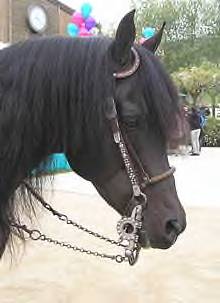
Finished "straight-up spade bit" with
California-style bosalito and bridle.
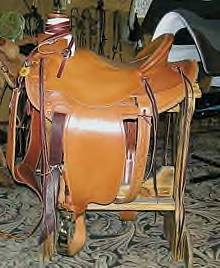
A "Wade" saddle, popular with working
ranch Buckaroo tradition riders, derived
from vaquero saddle designs |
Hawaiian Paniolo
The Hawaiian cowboy, the paniolo, is also a direct descendant
of the vaquero of California and Mexico. Experts in Hawaiian etymology
believe "Paniolo" is a Hawaiianized pronunciation of español. (The
Hawaiian language has no /s/ sound, and all syllables and words must end
in a vowel.) Paniolo, like cowboys on the mainland of North America, learned
their skills from Mexican vaqueros.
By the early 19th century, Capt. George Vancouver's gift
of cattle to Pai`ea Kamehameha, monarch of the Hawaiian Kingdom, had multiplied
astonishingly, and were wreaking havoc throughout the countryside. About
1812, John Parker, a sailor who had jumped ship and settled in the islands,
received permission from Kamehameha to capture the wild cattle and develop
a beef industry.
The Hawaiian style of ranching originally included capturing
wild cattle by driving them into pits dug in the forest floor. Once tamed
somewhat by hunger and thirst, they were hauled out up a steep ramp, and
tied by their horns to the horns of a tame, older steer (or ox) that knew
where the paddock with food and water was located. The industry grew slowly
under the reign of Kamehameha's son Liholiho (Kamehameha II). Later, Liholiho's
brother, Kauikeaouli (Kamehameha III), visited California, then still a
part of Mexico. He was impressed with the skill of the Mexican vaqueros,
and invited several to Hawai`i in 1832 to teach the Hawaiian people how
to work cattle.
Even today, traditional paniolo dress, as well as certain
styles of Hawaiian formal attire, reflect the Spanish heritage of the vaquero.
The traditional Hawaiian saddle, the noho lio, and many other tools of
the cowboy's trade have a distinctly Mexican/Spanish look and many Hawaiian
ranching families still carry the names of the vaqueros who married Hawaiian
women and made Hawai`i their home.
|
Bird Cage Theatre from Wikipedia
| The Bird Cage Theatre was a combination theater, saloon,
gambling parlor and brothel that operated from 1881 to 1889 in Tombstone,
Arizona during the height of the silver boom.
The Bird Cage Theatre was opened on December 25, 1881
by William “Billy” Hutchinson and his wife Lottie. Its name apparently
referred to the 14 “cages” or boxes that were situated on two balconies
on either side of the main central hall. These boxes (also referred to
as “cribs”) had drapes that could be drawn while prostitutes entertained
their clients. The main hall contained a stage and orchestra pit at one
end where live shows were performed.
One apocryphal story alleges that the Bird Cage Theatre
took its name from the popular early 20th-century song “A Bird in a Gilded
Cage”. According to this story, the establishment was originally named
the “Elite Theatre Opera House”. One day shortly after it opened, Eddie
Foy, Sr. and songwriter Arthur J. Lamb were standing at the bar discussing
the ladies who performed there, and Lamb allegedly said they were like
“birds in gilded cages”. He then |
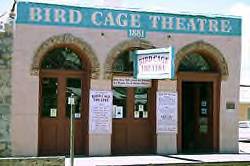
The Bird Cage Theater
as it appears today. |
worked out the song on a piano in the saloon, after which
it was sung by an unknown singer (Lillian Russell in some versions of the
story) who was called back by the roaring crowd eight times. However, Lamb
was born in 1870 (and therefore would have been no older than 11 or 12
years old at the time of this story). Moreover, it appears that the establishment
was named the Bird Cage Theatre from the time it opened. Its name was briefly
changed to the “Elite Theater” after it was acquired by Joe and Minnie
Bignon in 1882 before being changed back to the Bird Cage Theatre.
The Bird Cage Theatre operated continuously – 24 hours
a day, 365 days a year – for the next 8 years. It gained a reputation as
one of the wildest places in the country, prompting The New York Times
to report in 1882 that "the Bird Cage Theatre is the wildest, wickedest
night spot between Basin Street and the Barbary Coast". More than 120 bullet
holes are evident throughout the building.
Aside from Lillian Russell, many other famous entertainers
of the day were alleged to have performed there over the years, including
Eddie Foy, Sr., Lotta Crabtree and Lillie Langtry. In 1882, Fatima allegedly
performed her belly-dancing routine at the Bird Cage Theatre.
The basement poker room is said to be the site of the
longest-running poker game in history. Played continuously 24 hours a day
for eight years, five months, and three days, legend has it that as much
as 10 million dollars changed hands during the marathon game, with the
house retaining 10 percent. Some of the participants were Doc Holliday,
Bat Masterson, Diamond Jim Brady, and George Hearst. When ground water
began seeping into the mines in the late 1880s the town went bust, the
Bird Cage Theatre along with it. The poker game ended and the building
was sealed up in 1889.
The building was not opened again until it was purchased
in 1934, and the new owners were delighted to find that almost nothing
had been disturbed in all those years. It has been a tourist attraction
ever since, and is open to the general public year-round, from 8:00 am
to 6:00 pm daily.
The theater is said to be haunted and has been featured
in the paranormal investigation shows Ghost Hunters in 2006, Ghost Adventures
and Ghost Lab in 2009, and Fact or Faked: Paranormal Files in 2011.
|
Lasso from Wikipedia
| A lasso (play /læsou/ or /læ'sui/), also
referred to as a lariat, riata, or reata (all from Spanish la reata), is
a loop of rope that is designed to be thrown around a target and tighten
when pulled. It is a well-known tool of the American cowboy. The word is
also a verb; to lasso is to successfully throw the loop of rope around
something. Although the tool has several proper names, such terms are rarely
employed by those who actually use it; nearly all cowboys simply call it
a "rope," and the use of such "roping." Amongst most cowboys, the use of
other terms - especially "lasso" - quickly identifies one as a layman.
A lariat is made from stiff rope so that the noose stays
open when the lasso is thrown. It also allows the cowboy to easily open
up the noose from horseback to release the cattle because the rope is stiff
enough to be pushed a little. A high quality lasso is weighted for better
handling. The lariat has a small reinforced loop at one end, called a honda
or hondo, through which the rope passes to form a loop. The honda can be
formed by a honda knot (or another loop knot), an eye splice, a seizing,
rawhide, or a metal ring. The other end is sometimes tied simply in a small,
tight, overhand knot to |
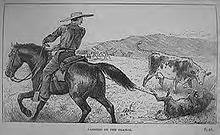
Lassoing on the prairie (from
the book Prairie Experiences in
Handling Cattle and Sheep,
by Major W. Shepherd, 1884) |
prevent fraying. Most modern lariats are made of stiff nylon
or polyester rope, usually about 5/16" or 3/8" in diameter and in lengths
of 28', 30', 35' for arena-style roping and anywhere from 45' to 70' for
Californio-style roping. The reata is made of braided (or less commonly,
twisted) rawhide and is made in lengths from 50' to over 100'. Mexican
maguey (agave) and cotton ropes are also used in the longer lengths.
The lariat is used today in rodeos as part of the competitive
events such as calf roping and team roping. It is also still used on working
ranches to capture cattle or other livestock when necessary. After catching
the cattle, the lariat can be tied or wrapped (dallied) around the horn,
a typical feature on the front of a western saddle. With the lariat around
the horn, the cowboy can use his horse as the equivalent of a tow truck
with a winch.
Part of the historical culture of both the vaqueros of
Mexico and the cowboys of the Western United States is a related skill
now called "trick roping", a performance of assorted lasso spinning tricks.
Will Rogers was a well-known practitioner of trick roping and the natural
horsemanship practitioner Buck Brannaman also got his start as a trick
roper when he was a child.
History
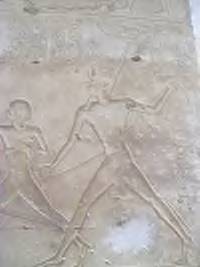
Pharaoh ready to rope the sacred
bull. A carving at the temple
of Seti I, Abydos, Egypt. |
Lassos are not only part of North American culture; relief
carvings at the ancient Egyptian temple of Pharaoh Seti I at Abydos, built
c.1280 BC, show the pharaoh holding a lasso, then holding onto a bull roped
around the horns. They were also used by Tatars and are still used by the
Sami people and Finns in reindeer herding. In Mongolia, a variant of the
lasso called an uurga (Mongolian: yypra) is used, consisting of a rope
loop at the end of a long pole. |
|
.
All articles submitted to the "Brimstone
Gazette" are the property of the author, used with their expressed permission.
The Brimstone Pistoleros are not
responsible for any accidents which may occur from use of loading
data, firearms information, or recommendations published on the Brimstone
Pistoleros web site. |
|